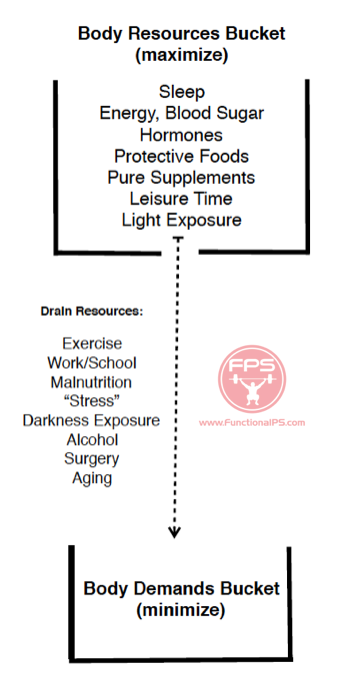Also see:
Stress — A Shifting of Resources
Collection of FPS Charts
Sugar (Sucrose) Restrains the Stress Response
Low Blood Sugar Basics
Ray Peat, PhD on Low Blood Sugar & Stress Reaction
Bowel Toxins Accelerate Aging
Exercise Induced Stress
Carbohydrate Lowers Exercise Induced Stress
Low Carb Diet – Death to Metabolism
Can Endurance Sports Really Cause Harm? The Lipopolysaccharides of Endotoxemia and Their Effect on the Heart
Running on Empty
Exercise and Endotoxemia
Ray Peat, PhD on Endotoxin
Endotoxin: Poisoning from the Inside Out
Ray Peat, PhD: Quotes Relating to Exercise
“Life is a condition alternating between excitation, destruction and unbalance, and reorganization, equilibrium and rest.” -Kurt Goldstein
The bucket pictogram below, inspired by the ideas of James Clear, explains many health concepts. The body resources bucket contains some of the primary factors that ensure good health. These resources are drained by the body’s demands (dotted arrow), which vary from person to person.

Bodily Resources vs Demands
The global objective is to maximize bodily resources and minimize demands to avoid momentary or permanent changes in bodily function. Tilt the scales in your favor.

The body’s resources are finite, and the rate at which they are depleted is determined by your body’s demands. Maintain body balance by ensuring that your resources always trump your body’s demands by continually depositing resources on a daily basis and reducing demands where possible.
Young people are free of disease because their bodily resources are so vast that demands are easily met. When young people are compromised, they recover easily because they can quickly tilt the scales back in their favor.
There are direct parallels between finance and these two buckets. The resources bucket is analogous to a savings account, and the demands bucket represents total expenses. Don’t spend more money than you have to avoid financial turmoil or bankruptcy. Make deposits into your resources bucket on a daily basis and reduce expenses/demands to ensure protection from resource bankruptcy and a compromised body.
Here are some additional bullet points:
• The contents of each bucket will vary for each person. Some of the most basic elements are listed that apply to most people.
• Weight management and health concerns at their base come about due to imbalance between resources and demands. Each person has his/her own adaptation to the imbalance. Consider how robust your resources are at present and have been over your lifespan. Your present state is a reflection of all your years put together.
• Simple example of this pictogram at work is when one gets a cold or sickness. Someone gets a cold because demands were excessive relative to their (immune) resources. When someone gets a cold, he/she doesn’t go exercise vigorously (which is another demand) because energy levels and appetite are low. Rather, he/she builds lowers demands by taking time off from work/school if possible and sleeping/resting more and eventually eating well to build up his/her resources again to achieve recovery. If a person cannot aggregate the resources necessary to overcome the illness, the illness remains. How often you get sick and how long it takes you to recover when you do get sick is one indicator of how robust your resources bucket is.
• Restorative sleep and midday naps are an outstanding way to lower demands on your system.
• A person with sleep difficulties (sleep apnea, mouth breathing while sleeping, insomnia, waking several times during the night, waking feeling unrested, nocturnal urination, teeth grinding) is often the individual with high demands but low available resources. This creates a vicious cycle because of the inability to lower demands significantly via restorative sleep.
Additional Resources:
“The Stress of Life” by Hans Selye (book)
“Stress Without Distress” by Hans Selye (book)
“Why Zebras Don’t Get Ulcers” by Robert Sapolsky (book)
“Theory of Cumulative Stress – How to Recover When Stress Builds Up” by James Clear (online)
